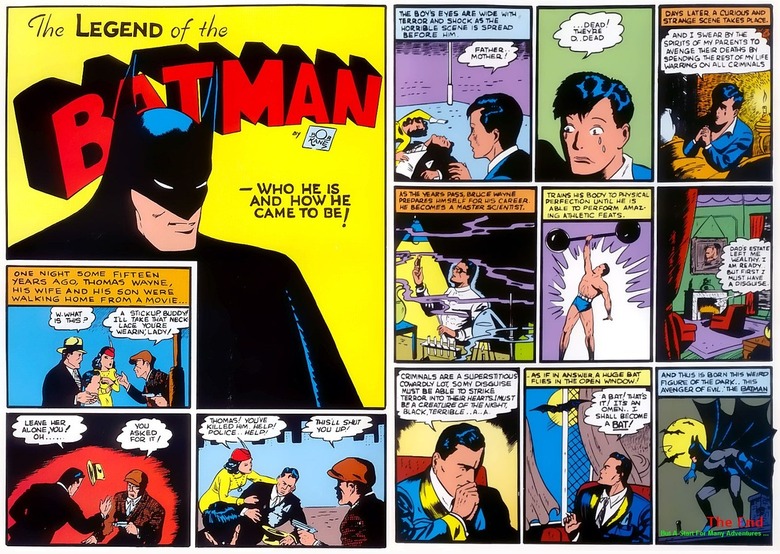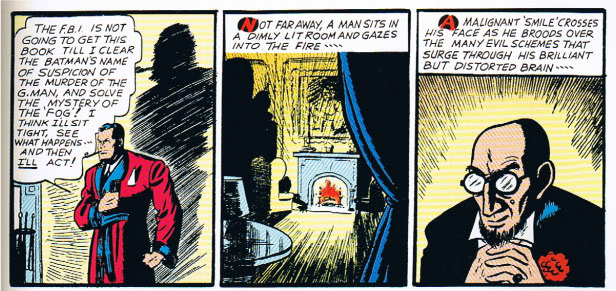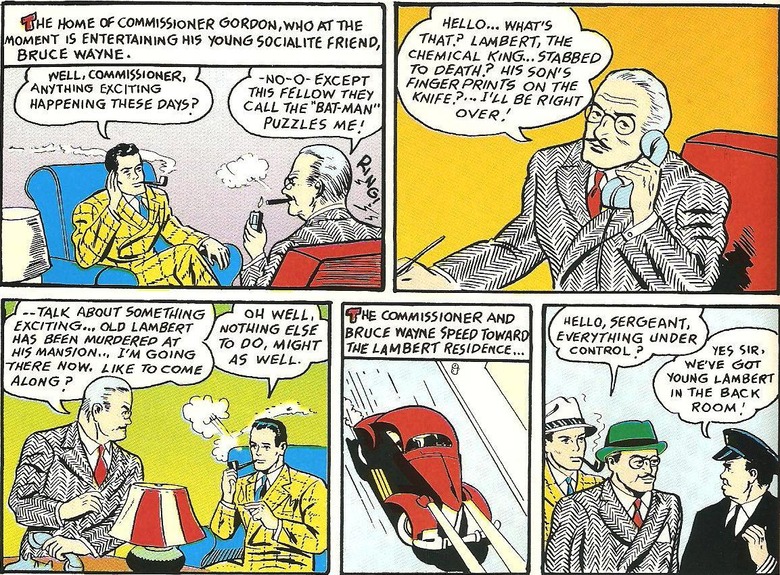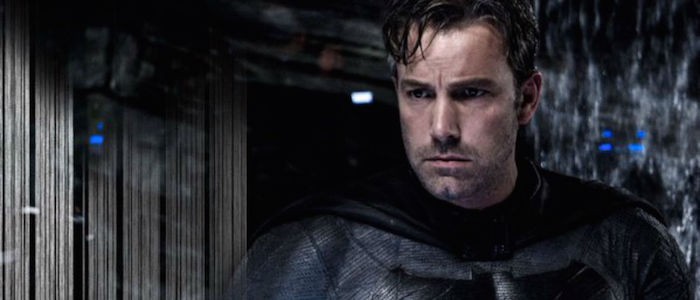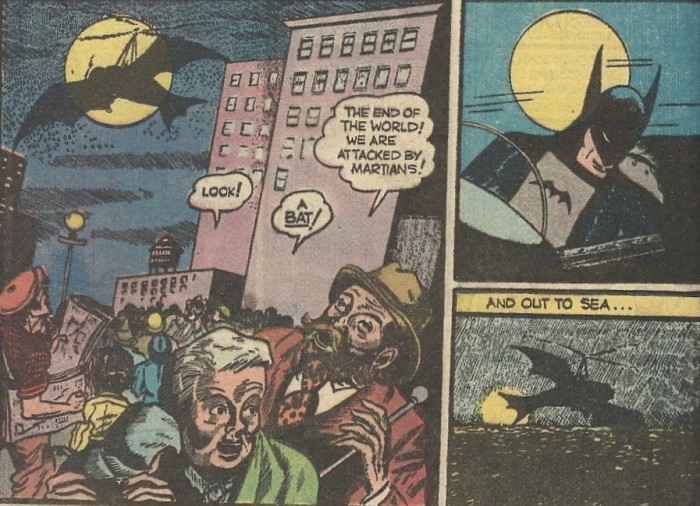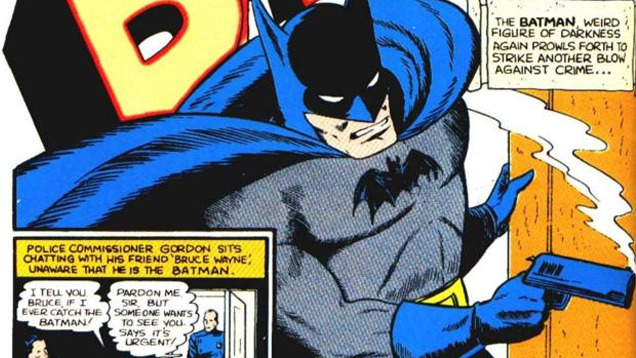Batman V The Golden Age: How Ben Affleck's Dark Knight Compares To The Original Character
Last week, I wrote about how the Superman of Batman v Superman: Dawn of Justice compared to the original incarnation of the character who was introduced in the pages of Action Comics in 1938. In a nutshell, neither version lined up with the popular vision of the character. Golden Age Superman and Zack Snyder's Superman are not the Superman the public knows. Seeing how each depiction diverges from the norm made for a compelling personal study.
And since we're still talking about this movie, I figured I might as well give the same treatment to Ben Affleck's Batman and compare his take to the original Golden Age version, who debuted in Detective Comics #27 in May 1939 via the pen of writer Bill Finger and the pencil of artist Bob Kane. As with the previous Superman article, I based all of these observations on a reading of the first year of Batman stories. And as with that previous article, the character on display here is far from the character we know and love. And also like that previous article, this is not intended to be a defense of how Zack Snyder depicts Batman (so much of it rubs me the wrong way), but rather a peek down the pop culture history rabbit hole.
Bruce Wayne and the Origins of The Bat-Man
The entire world is so familiar with Batman's origin story that the mere fact that Zack Snyder told it again in Batman v Superman has been a subject of discussion and controversy amongst fans. How many times do we have to watch Thomas and Martha Wayne get gunned down in a mugging gone wrong? How many times do we have to watch young Bruce Wayne cry over the bodies of his murdered parents outside of a movie theater? How many times will Martha's necklace be the focal point of this confrontation?
Snyder's depiction of the Waynes' murder is borderline fetishistic. Shot in extreme slow-motion, the intent is to drill every painful millisecond of this encounter into our minds, forcing us to watch the moment that changed young Bruce's life in agonizing, traumatizing detail. You almost can't blame Snyder for taking an overblown approach to this particular piece of the Batman mythos – we are so intimately familiar with it that recreating it with sledgehammer force feels like the only option left. There's no room for subtlety in a film that is already packed with incident.
It's weird to read the earliest Batman comics and realize that this origin story didn't come into play until a little later. In his first six adventures in the pages of Detective Comics, there is no mention of Bruce's parents or how he decided to declare war on criminals to avenge them. There is just Bruce Wayne, the young socialite who is apparently so bored with his humdrum life that he's taken up crimefighting because there's nothing better to do. These early Batman stories are akin to the earliest pulp heroes – the Bat-Man (as he is initially called) does what he does because that's just what he does. He doesn't need any stinking motivation! This is his hobby. It's actually pretty amusing how many times Bruce Wayne ducks out of a dangerous situation because it's too "melodramatic" or because he has something better to do, only to return a panel later as Batman.
The seventh Batman adventure, collected in Detective Comics #33, finally supplies Batman with his iconic backstory, dedicating two pages to the death of the Thomas Wayne and Mrs. Wayne (Martha isn't named yet) and explaining that young Bruce trained himself to be an extraordinary chemist and peak physical specimen in order to battle crime. And then a bat flies through his window and gives him the rest of the necessary motivation. It's all incredibly straightforward and it's no wonder that later filmmakers (from Snyder to Christopher Nolan) would feel compelled to spice it up a bit. No, young Bruce doesn't fall into the Batcave in these early stories. Heck, the Batcave doesn't even exist yet.
The Rogues Gallery
Few fictional heroes are as defined by their villains as Batman, whose adversaries are so well-realized and indelible that they tend to dominate the larger DC comic book universe these days. You can't go a week without another superhero running into a bad guy introduced in the streets of Gotham City. Heck, just look at the upcoming Suicide Squad, where more than a few of the villains in the line-up are Batman antagonists. There are enough of them that Batman himself is going to pop in for a cameo. These guys are a big deal.
And even though no proper Batman villains rear their heads in Batman v Superman, they still linger over the movie. Some exist as Easter eggs, like graffiti that all but reads "the Riddler was here." Others exist as offscreen reminders of past events, like graffiti scrawled all over the armor of an absent Robin, which makes it perfectly clear that the Joker was there and he wasn't taking prisoners on that particular day. Even in a movie where Batman fights Superman villains, these guys can't help but be present. They cast large shadows.
So it's strange to watch Batman do battle with enemies that aren't the Penguin and Mr. Freeze and Poison Ivy and Bane and the rest of that crew. In his earliest adventures, Batman takes on an eclectic crew of crooks and maniacs, but few of them have that instant, iconic jolt provided by his most infamous baddies. There are a fair number of jewel thieves and white collar criminals, the kinds of guys who plot to take over companies by stealing contracts and murdering their partners. Many of these guys aren't breathing in the final panels (more on that in a bit), so the chances of them becoming classic, recurring villains are slim.
But soon enough, Detective Comics is letting its pulpy flag fly in a big way. Although Batman continues to fight his fair share of ordinary criminals, he's soon doing battle with Doctor Death, a mad scientist type who actually manages to survive his two encounters with Batman so he can return for later adventures (although he is horribly mangled and gets a monstrous new look). Even better is Master Monk, a Hungarian vampire with a giant ape henchman who tries to kill Batman by tossing him into his werewolf pit. While the all-powerful Superman was tackling social justice issues, the mortal Batman was literally saving the world from a quartet of mad scientists whose ray-gun dirigibles literally threaten the safety of every person on Earth. In his modern incarnations, Batman tends to be the street-level hero, fighting his way through the gutter to pave a way for hopefully brighter future while Superman handles the gigantic, world-saving adventures. It's fascinating to see their roles reversed this early on.
Eventually, Batman does meet the first member of his regular rogues gallery: the mad scientist Hugo Strange, who is more of a riff on Sherlock Holmes' chief nemesis Professor Moriarty than his later "psychopathic psychologist" incarnation. A few issues after that, one issue beyond where this particular project ended, the Joker makes his grand debut.
Allies, Friends and Accomplices
Just as interesting as the lack of Batman's regular villains in his earliest Golden Age adventures is the lack of his familiar allies. And those who do show up have yet to develop into the characters we know today. Take Commissioner Gordon, who shows up on the first page of Batman's first adventure and is almost immediately unrecognizable. This early incarnation of the character is a buddy of that young socialite Bruce Wayne. This Gordon isn't fond of "the Bat-Man" and when he does bring him up, it's with disdain and confusion. After all, he's making the police force of not-yet-Gotham City look bad!
Modern Gordon has been flip-flopped. Now, the commissioner is a loyal ally to Batman himself, keeping him in the loop on what's going on in the city and working with him directly to conduct a war on crime. The popular image of Gordon rarely has a strong opinion of Bruce Wayne – he's just some rich guy and they are certainly not good friends.
Also absent in the early days is Alfred the loyal butler, which means that Batman's early days are incredibly lonely. There is almost no time devoted to Bruce's time outside of the cape and cowl, as there is no one waiting for him at home and no one to provide a helping hand when things go wrong. When he's shot by a criminal, Bruce Wayne strips out of his costume and literally drives to the "family doctor." In the age of Alfred the multi-tasking right-hand-man, such a thing would be unthinkable.
However, Detective Comics #38, the final issue of this project, does introduce Batman's most famous companion and he arrives almost completely intact. Dick Grayson, a.k.a. Robin, is introduced through his famous origin story. His parents are the Flying Graysons, performers at Haly's Circus, who are killed as part of an extortion attempt by a gang of criminals. And Bruce Wayne still takes in young Dick as his ward and trains him as a crimefighter so he can seek revenge. A few details have changed over the years: early Dick takes his superhero moniker from Robin Hood, not for bird-related reasons, and Batman whisks this kid away from the scene of the crime and makes him pledge an oath (by candlelight!) to dedicate his life to battling criminals. In retrospect, it's amazing how irresponsible the entire concept of Robin truly is, but Detective Comics never pauses to even consider that there's anything wrong with a man stealing a grieving kid from a crime scene and asking him if he wants help with his revenge. But hey, that's Golden Age comics for you. You just have to roll with it.
Compare this to Batman v Superman, where Batman has been around for so long that most of his allies seem to have abandoned him. Robin is dead. Gordon is AWOL. There is only Alfred, poor, overworked, Alfred, who has given over his life to worrying about the safety of Master Bruce. It's lonely being Golden Age Batman, but it's especially lonely being 2016 movie Batman.
The Definition of Justice
What is justice for Batman? For Ben Affleck's incarnation of the character, it's all about taking down criminals with extraordinary force, even branding the especially nasty guys so they'll be forever marked. His war on the criminal underworld is absolute and never-ending – you can see in Affleck's graying hair and tired eyes a man who is more than a little unhinged in his quest to clean up the streets of his city. There is something inherently psychopathic about a man who dresses up like a bat so he can punch people in the face (and shatter their spines and so on) and Batman v Superman leans heavily on this. Batman's quest for justice takes place in the mean streets and the gutters. He's punishment incarnate. He's a brute.
In comparison, Golden Age Batman is downright jolly, even if the seeds of darkness that everyone from Frank Miller to Zack Snyder would later cultivate are present. While he's not the scientist/adventurer of the Silver Age, this Batman often wears a big 'ol grin as he fights crime. He even wisecracks. This Batman may be on a quest of vengeance against the entire world, but he seems to be actively having a good time in every moment. He's not tortured in the slightest. From a modern angle, a vigilante in a bat suit who cheerfully embarks on a one-man-war against criminal organizations while grinning like a loon actually feels crazier than the brooding maniac of Batman v Superman, but that would be to miss the point. Golden Age Batman is all about these fast, silly adventures. He smiles because his adventures are supposed to be fun, not haunting examinations of the inner self.
And while Golden Age Batman does fight vampires and mad scientists and wannabe dictators, his bread-and-butter enemies default to fairly ordinary criminals who want to disrupt the lives of ordinary citizens and get away with a quick and easy buck. If Golden Age Superman was about disrupting the status quo and helping people rise up to a better place, Golden Age Batman is about maintaining that status quo and keeping the bad guys from breaking the social order. It's an inadvertently fascinating study in contrasts...and it's a pity that Batman v Superman couldn't capitalize on that.
While we're here, it should be noted that there's one issue of Detective Comics where not-yet-Gotham City is attacked by villains with high-tech weapons, who seemingly decimate a large portion of the city. The attack happens when Bruce Wayne is out of costume, so he rushes into the wreckage and assists in the rescue operations. Whether intentional or not, it's a fairly direct mirror of Batman v Superman's opening scene.
Gadgets and Skills
It's telling that Batman v Superman doesn't feel the need to provide proper introductions to many aspects of the Batman mythos. The Batmobile shows up and we accept it because Batman always drives the Batmobile. We see a Batarang at a crime scene and we instantly recognize Batman's weapon of choice We cut to the Batcave and we accept it because Batman always operates out of the Batcave. When Batman gets in the Batplane for the third act, we don't even blink because Batman has a Batplane. He always has. Or at least he's had them long enough.
But Golden Age Batman is severely lacking in all of the amenities that come packaged with his later incarnations. At one point in these early adventures, Batman has to borrow a criminal's car so he can dump his unconscious body on the front steps on the police station. Thus is life without the aid of a Batmobile.
Still, Batman isn't entirely lacking in tools of the superhero trade. Who needs a fancy grappling gun when you have a silken rope that you can use to climb buildings and traverse tricky spaces? Who needs any other gadgets when you have a gas pellet for any and all situations? Seriously. Golden Age Batman uses his silken rope and his gas pellets a lot.
Other gadgets eventually come into play. The Batarang surfaces before too long and Batman manages to combine it with his silk rope to reach difficult locations. The "Batgyro" surfaces when Batman needs to chase a villain to Europe and within a few pages, the narration has rechristened it as the Batplane. It's even stored in a secret hangar, which is the closest these early stories come to depicting the Batcave. A few issues after having to borrow a criminal's car, we see Batman driving his "specially built high power auto," which isn't quite the Batmobile (it's bright red), but it's a start.
Oh, and Batman utilizes night vision goggles, which was a brand new technology in 1939. Hey, when you're a millionaire with a death wish, you can buy just about anything.
One thing Golden Age Batman definitely has in common with Ben Affleck's version is his ability to kick some serious ass in a fistfight. Although the early issues make a big point about Batman's physical prowess, Detective Comics #36 is the first time we see Bruce actually take on an entire team of criminals and make it look easy. The first adventures featured straightforward brawls with one or two villains at a time, but within a year, the Bat-Man was breaking out jiu-jitsu moves against half a dozen crooks at once and taking them down with extreme prejudice. We take Batman's ability to effortlessly dismantle an entire room's worth of villains for granted, so watching him reach that point in these early comics is a real treat.
Batman and Killing
And here we reach a sore point. About a year into his original run, an editorial mandate was passed down that Batman would no longer take lives. This decision was incorporated into the mythology of the character and Bruce Wayne became a vigilante who believed in reformation and the preciousness of human life. To kill someone would reduce him to the level of his parents' killer. This choice would be his blessing and his curse for years to come, especially as his most dangerous villains kept on returning to the streets because Batman felt a moral obligation to not put them down for good.
The Batman of Batman v Superman doesn't give a shit about human life and neither does the Golden Age Batman during his first year. Both feel startlingly out-of-character: a Batman who casually kills or even lets villains die doesn't feel like Batman. The Golden Age version was a rough draft and a work-in-progress that ultimately evolved into the version we know and love. The Batman of Zack Snyder's deliberately goes against decades of Batman not murdering his foes in cold blood. There is no good excuse for this.
While Ben Affleck's Batman guns down bad guys and lets others get blown up by hand grenades and crushes people with the Batmobile, Golden Age Batman's killing streaks tend to me more simple. He flings more than a few villains out windows. He knocks a pilot unconscious so he'll crash his plane and perish. He swaps clothes with an henchmen so he can get vaporized by a ray-gun in his place. He snaps a neck, impales a henchman into a sword, and even pushes a man into a vat of acid. He is ice cold. Batman is even seen wielding a gun on occasion, but he never actually pulls the trigger. He's too busy killing people in a variety of other ways. Actually, I take that back. Batman does use a pistol loaded with silver bullets to execute a whole clan of slumbering vampires.
Much like how Superman has been leveling cities since 1938, Batman has been killing since 1939. But we don't have to like it.

